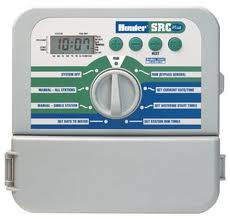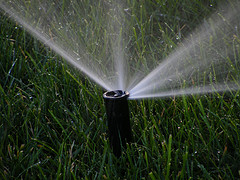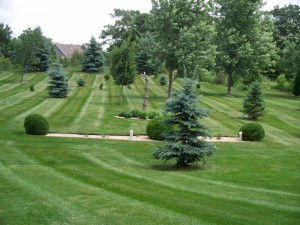Snow Plowing and Lawn Care Tips 



When the seasons change we need to adjust with them. Some simple actions we take at the beginning or end of a season can save potential headaches and money. These are some simple tips for each season to refresh our memories.
Lawn Care Tips
 Spring
Spring
There are several actions you can take to improve the overall appeal of your property.
- Spread granular, slow-acting fertilizer
- Water your lawn frequently, especially if there has been a break in precipitation
Grass needs 1 to 2 inches of water (including rainfall) each week to thrive. The more hydrated your lawn is, the better the root growth will be. Leave grass clippings on lawn as they will decompose leaving nutrients such as nitrogen to the soil.
 Summer
Summer
- Lawn mowing the turf around 3″, during warmer temperatures
- Treat weeds and bare spots as soon as you see them
- Maintain a well hydrated lawn ladybugs can provide a chemical-free way to reduce the pest population of harmful, plant-eating insects
 Autumn
Autumn
- Water trees and shrubs thoroughly and mulch before the first frost
- Cutting the grass a bit shorter just before winter will prevent matting under snow
- Fall lawn care; remove all debris from turf, such as leaves and sticks
- Core aerate turf every year!
Snow Plowing Tips
 Winter
Winter
- Putting markers at the edge of your lawn will help you avoid damaging it when you’re shoveling, snow blowing or snow plowing
- If you can see the turf when the snow is still presence, avoid walking on it as much as possible.
- When a snow event is prominent, make sure to get plenty of rest
Adequate Watering
Watering your grass is one of the most important items to maintaining a healthy lawn. Obtaining adequate hydration requires at least 2 inches of moisture per week. Depending on your climate this may increase to 2 inches of water twice per week.
By getting down into the soil 2 inches you’ll promote great root structure for your grass. Just dampening the soil or watering your lawn everyday a little bit will only allow the water to just penetrate the soil. This will make for a very shallow root system, exactly what you do not want.
Lawn Watering Management

Just before dawn is the best time to water lawn, this gives plenty of time to dry during the day. You want to maximize the amount of water consistent with good growth but with the least amount of surface wetness.
How do you know if you watered 2 inches? The easiest way to tell (not the most accurate, but it is a good indicator) is to lay out a few containers and turn on your sprinkler or irrigation system.
When you have about 2 inches of water in the container, then you could assume that you have watered 2 inches into the ground. Perhaps the best and most accurate way is to take soil sample plugs in a few different locations and visually see how far down the moisture is going.
How often should you be watering your lawn?
Lawn watering everyday is a waste of water and money. Too much watering can be harmful to your lawn creating a perfect environment for pests and diseases. A healthy lawn needs to become dry between watering. Turf that is allowed to dry will send roots further down into the soil to find new moisture.
Irrigation System
In-ground irrigation systems are a great way to monitor lawn watering. If you want to reward your lawn and can afford, installing an irrigation system for your property will help you control watering adequacy.
How long your turf is being irrigated will keep your water bill low, since we forget sometimes the sprinkler is on and forget to shut it off.
Most homeowner and commercial irrigation sprinkler systems will have an electrical controller. There are many types of irrigation controllers with different capabilities, but most will give you the options to set the time and length of watering.
Core Aeration
If your soil is compacted you may experience water run off or pooling. Therefore, your lawn will not absorb the water, it will most likely evaporate. In this case it is time to core aerate, and reward your turf for hanging in there.
The lawn weed, crabgrass (Digitaria spp) is a warm-season annual weed, which means it reproduces by seed.
How do you kill crabgrass? The short answer: applying pre-emergent herbicides at the right time is the best way to kill crabgrass. Most lawn care companies will include this in their fertilization and weed control lawn care programs.
There are many different types of pre-emergent herbicides for killing crabgrass. “Weed and feed” products often contain pre-emergent herbicides, although some question whether their concentration is strong enough to be effective. Here are 2 types of pre-emergent herbicides: Dimension and Tupersan.
DOs and DON’Ts
Preemergent Herbicides for Killing Crabgrass: When to Apply
To get rid of crabgrass it helps to know its life cycle. When spring soil temps (at a depth of 2″-3″) reach 55-60 degrees Fahrenheit, the first crabgrass seed will germinate. From mid-summer to fall, crabgrass produces seed. The crabgrass plants (but not the seeds) are killed by frosts in autumn.
Pre-emergent herbicides come in either granular or liquid form and kill crabgrass seedlings as they germinate. If you are going to core aerate or dethatch your lawn after applying pre-emergent herbicides, these ACTIONS WILL BE FOR NOT. Aerate lawns beforehand, instead.
Pre-emergent herbicides kill crabgrass at a specific time: before its seedlings emerge. Successfully getting rid of crabgrass in this manner, timing is essential. Apply pre-emergent herbicides before germination, but not too far ahead. Crabgrass germination coincides approximately with the blooming of the lilac bushes.
Types of Pre-emergent Herbicides for Killing Crabgrass
*Dimension (active ingredient, dithiopyr) is safe to use on most lawn grasses (check label first) and provides long-lasting coverage — an important consideration, since not all crabgrass seed germinates at once. Thus Dimension will kill later-germinating crabgrass, too. Dimension also displays some effectiveness as a post-emergent herbicide.
*Tupersan (active ingredient, siduron) is worth mentioning because, unlike other
pre-emergent herbicides, it will not damage germinating lawn grass seed. In fact, its active ingredient is often combined with starter fertilizers. Alternatively, for newly-seeded lawns, wait until after 3 mowings (or 3 months, to be on the safe side) before applying pre-emergent herbicides.
Using Pre-emergent Herbicides for Killing Crabgrass:
Do:
*Irrigate afterwards: water activates pre-emergent herbicides.
*Re-apply pre-emergent herbicides, if you question your product’s coverage. Because
crabgrass seedlings do not all germinate at once, re-application can kill some of the
later-germinating crabgrass.
*Follow label directions and apply the proper rate. Measure the lawn area and calibrate your spreader carefully. The lawn weed, crabgrass (Digitaria spp) is a warm-season annual weed, which means it reproduces by seed.
How do you kill crabgrass? The short answer: applying pre-emergent herbicides at the right time is the best way to kill crabgrass.
Don’t:
*Dethatch or aerate the lawn after applying pre-emergent herbicides.
*Apply pre-emergent herbicides on new sod.




 Spring
Spring Summer
Summer Autumn
Autumn Winter
Winter



